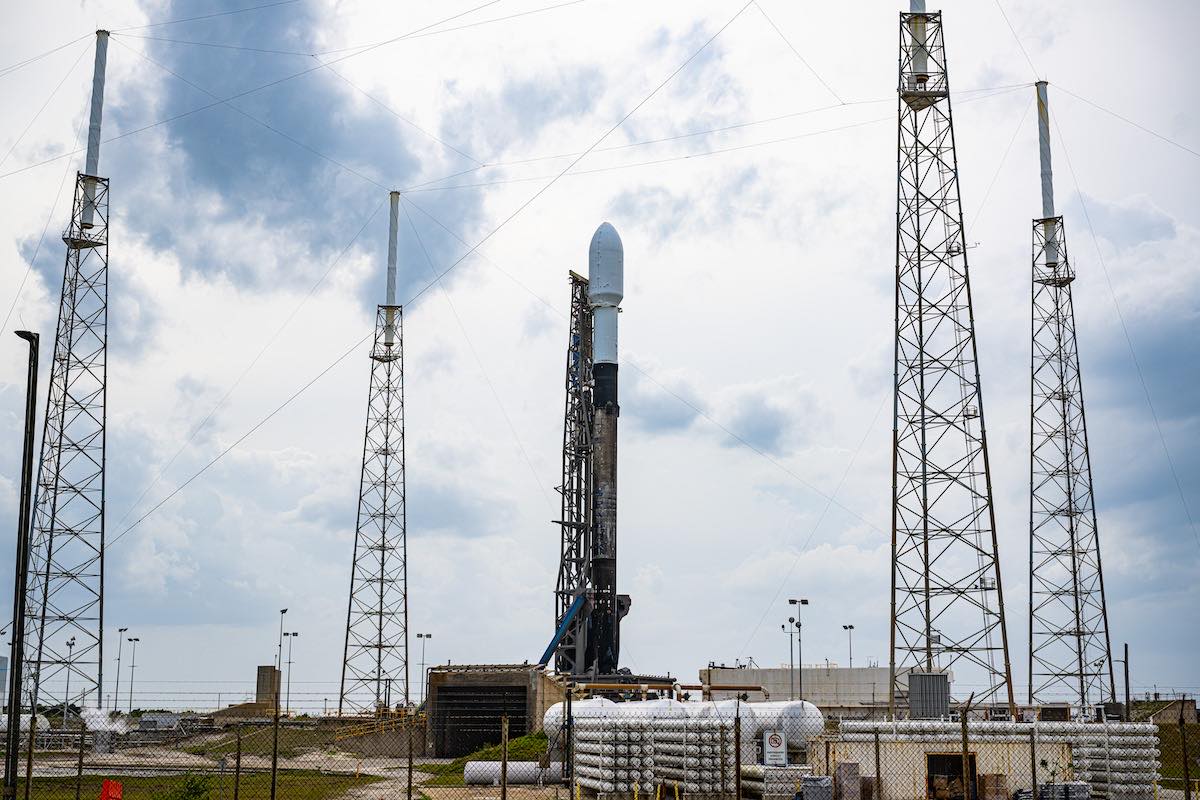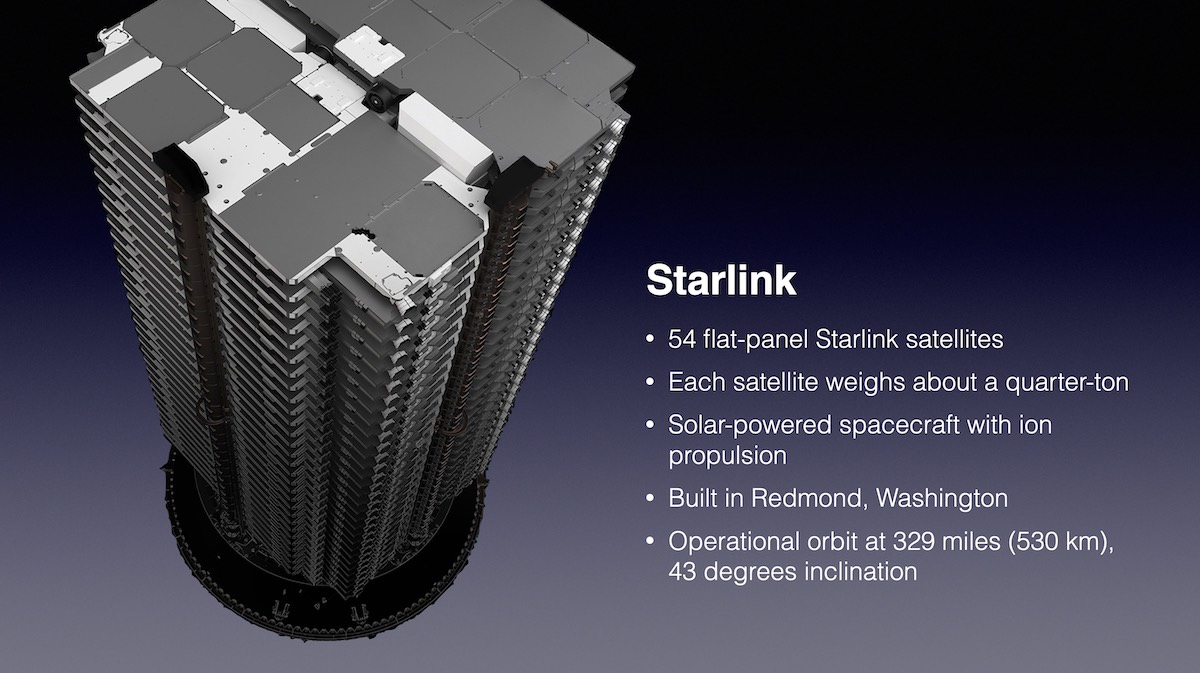Space News & Blog Articles
Live coverage: SpaceX ready for first launch into Starlink Gen2 constellation
SpaceX is scheduled to launch a Falcon 9 rocket from Cape Canaveral Wednesday with 54 more Starlink internet satellites, a mission that will begin populating a new orbital shell authorized by federal regulators earlier this month for the company’s Starlink Gen2 network.
Liftoff of the Falcon 9 rocket from pad 40 at Cape Canaveral Space Force Station on SpaceX’s Starlink 5-1 mission is set for 4:40 a.m. EST (0940 GMT) Wednesday. The mission will be SpaceX’s 60th launch of the year, with one more Falcon 9 flight set to blast off later this week from Vandenberg Space Force Base, California, with an Israeli Earth-imaging satellite.
There’s a greater than 90% chance of favorable weather for launch Wednesday, according to the U.S. Space Force’s 45th Weather Squadron at Cape Canaveral.
The 54 satellites launching Wednesday will be the first spacecraft deployed into a new segment of the Starlink constellation. The Falcon 9 rocket will aim to release the 54 satellites at an orbital altitude and inclination set aside for use by SpaceX’s second-generation Starlink network, which the company eventually intends to launch on the new Starship mega-rocket.
SpaceX is developing a much larger, higher-power Starlink satellite platform capable transmitting signals directly to cell phones. But with the Starship’s first orbital test flight still on hold, SpaceX officials have signaled they will start launching the Gen2 satellites on Falcon 9 rockets. Elon Musk, SpaceX’s founder and CEO, suggested in August that the company could develop a miniature version of the Gen2 satellites to fit on the Falcon 9 rocket.
SpaceX has revealed little information about the Starlink 5-1 mission set to take off Wednesday. It’s unclear whether SpaceX will use the satellites to test out new hardware or software to be used on the Gen2 network.
But the circumstances of the flight suggest the Starlink satellites on-board the Falcon 9 rocket are similar in size to SpaceX’s existing Starlink spacecraft, and not the larger Gen2 satellites destined to fly on the huge new Starship rocket, or even the mini Gen2 satellites Musk mentioned earlier this year. There are 54 satellites on the Falcon 9 launcher set to fly Wednesday, the same number SpaceX has launched on many recent Starlink missions.
 File photo of a Falcon 9 rocket on pad 40 at Cape Canaveral Space Force Station. Credit: Michael Cain / Spaceflight Now / Coldlife Photography
File photo of a Falcon 9 rocket on pad 40 at Cape Canaveral Space Force Station. Credit: Michael Cain / Spaceflight Now / Coldlife Photography
The Federal Communications Commission granted SpaceX approval Dec. 1 to launch up to 7,500 of its planned 29,988-spacecraft Starlink Gen2 constellation. The regulatory agency deferred a decision on the remaining satellites SpaceX proposed for Gen2.
The FCC previously authorized SpaceX to launch and operate up to 12,000 Starlink satellites, including roughly 4,400 first-generation Ka-band and Ku-band Starlink spacecraft that SpaceX has been launching since 2019. SpaceX also received regulatory approval to launch more than 7,500 Starlink satellites operating in a different V-band frequency.
SpaceX told the FCC earlier this year it planned to consolidate the V-band Starlink fleet into the larger Gen2 constellation.
The Gen2 satellites could improve Starlink coverage over lower latitude regions, and help alleviate pressure on the network from growing consumer uptake. SpaceX said earlier this month the network now has more than 1 million active subscribers. The Starlink spacecraft beam broadband internet signals to consumers around the world, connectivity that is now available on all seven continents with testing underway at a research station in Antarctica.
“Our action will allow SpaceX to begin deployment of Gen2 Starlink, which will bring next generation satellite broadband to Americans nationwide, including those living and working in areas traditionally unserved or underserved by terrestrial systems,” the FCC wrote in its Dec. 1 order partially approving the Starlink Gen2 constellation. “Our action also will enable worldwide satellite broadband service, helping to close the digital divide on a global scale.
“At the same time, this limited grant and associated conditions will protect other satellite and terrestrial operators from harmful interference and maintain a safe space environment, promoting competition and protecting spectrum and orbital resources for future use,” the FCC wrote. “We defer action on the remainder of SpaceX’s application at this time.”
Specifically, the FCC granted SpaceX authority to launch the initial block of 7,500 Starlink Gen2 satellites into orbits at 525, 530, and 535 kilometers, with inclinations of 53, 43, and 33 degrees, respectively, using Ku-band and Ka-band frequencies. The FCC deferred a decision on SpaceX’s request to operate Starlink Gen2 satellites in higher and lower orbits.
The Starlink 5-1 mission set to fly Wednesday will target the 530-kilometer-high (329-mile) orbit at an inclination of 43 degrees to the equator.
 The Starlink 5-1 mission will deploy 54 internet satellites into orbit. Credit: Spaceflight Now
The Starlink 5-1 mission will deploy 54 internet satellites into orbit. Credit: Spaceflight Now
Going into Wednesday’s mission, SpaceX has launched 3,612 Starlink satellites on more than 60 Falcon 9 rocket missions, including prototypes and failed spacecraft. The company currently has more than 3,200 functioning Starlink satellites in space, with about 3,000 operational and nearly 200 moving into their operational orbits, according to a tabulation by Jonathan McDowell, an expert tracker of spaceflight activity and an astronomer at the Harvard-Smithsonian Center for Astrophysics.
The first-generation Starlink network architecture includes satellites flying a few hundred miles up, orbiting at inclinations of 97.6 degrees, 70 degrees, 53.2 degrees, and 53.0 degrees to the equator. Most of SpaceX’s recent Starlink launches have released satellites into Shell 4, at an inclination of 53.2 degrees, after the company largely completed launches into the first 53-degree inclination shell last year.
Shell 5 of the Starlink network was widely believed to be one of the polar-orbiting layers of the constellation, at 97.6 degrees inclination. But the name of Wednesday’s mission — Starlink 5-1 — might suggest SpaceX has changed the naming scheme for the Starlink shells.
SpaceX’s launch team will be stationed inside a launch control center just south of Cape Canaveral Space Force Station for Wednesday’s predawn countdown. SpaceX will team will begin loading super-chilled, densified kerosene and liquid oxygen propellants into the Falcon 9 vehicle at T-minus 35 minutes.
Helium pressurant will also flow into the rocket in the last half-hour of the countdown. In the final seven minutes before liftoff, the Falcon 9’s Merlin main engines will be thermally conditioned for flight through a procedure known as “chilldown.” The Falcon 9’s guidance and range safety systems will also be also configured for launch.
After liftoff, the Falcon 9 rocket will vector its 1.7 million pounds of thrust — produced by nine Merlin engines — to steer southeast over the Atlantic Ocean. The launch marks the resumption of Starlink missions from Cape Canaveral using the southeasterly launch corridor, as SpaceX did last winter to take advantage of better sea conditions for landing of the Falcon 9’s first stage booster.
Throughout the summer and fall, SpaceX launched Starlink missions on paths toward the northeast from Florida’s Space Coast.
The Falcon 9 rocket will exceed the speed of sound in about one minute, then shut down its nine main engines two-and-a-half minutes after liftoff. The booster stage will release from the Falcon 9’s upper stage, then fire pulses from cold gas control thrusters and extended titanium grid fins to help steer the vehicle back into the atmosphere.
Two braking burns will slow the rocket for landing on the drone ship “A Shortfall of Gravitas” around 410 miles (660 kilometers) downrange approximately nine minutes after liftoff.
The Falcon 9’s reusable payload fairing will jettison during the second stage burn. A recovery ship is also on station in the Atlantic to retrieve the two halves of the nose cone after they splash down under parachutes.
Landing of the first stage on Saturday’s mission will occur moments after the Falcon 9’s second stage engine cuts off to deliver the Starlink satellites into orbit. Separation of the 54 Starlink spacecraft, built by SpaceX in Redmond, Washington, from the Falcon 9 rocket is expected around 15 minutes after liftoff.
The Falcon 9’s guidance computer aims to deploy the satellites into an elliptical orbit at an inclination of 43 degrees to the equator, with an altitude ranging between 131 miles and 210 miles (212-by-338 kilometers). After separating from the rocket, the 54 Starlink spacecraft will unfurl solar arrays and run through automated activation steps, then use ion engines to maneuver into their operational orbit.
ROCKET: Falcon 9 (B1062.11)
PAYLOAD: 54 Starlink satellites (Starlink 5-1)
LAUNCH SITE: SLC-40, Cape Canaveral Space Force Station, Florida
LAUNCH DATE: Dec. 28, 2022
LAUNCH TIME: 4:40:10 a.m. EST (0940:10 GMT)
WEATHER FORECAST: Greater than 90% chance of acceptable weather; Low risk of upper level winds; Moderate risk of unfavorable conditions for booster recovery
BOOSTER RECOVERY: “A Shortfall of Gravitas” drone ship northeast of the Bahamas
LAUNCH AZIMUTH: Southeast
TARGET ORBIT: 131 miles by 210 miles (212 kilometers by 338 kilometers), 43.0 degrees inclination
LAUNCH TIMELINE:
T+00:00: Liftoff T+01:12: Maximum aerodynamic pressure (Max-Q) T+02:29: First stage main engine cutoff (MECO) T+02:32: Stage separation T+02:39: Second stage engine ignition T+02:44: Fairing jettison T+06:44: First stage entry burn ignition (three engines) T+07:00: First stage entry burn cutoff T+08:26: First stage landing burn ignition (one engine) T+08:38: Second stage engine cutoff (SECO 1) T+08:47: First stage landing T+18:43: Starlink satellite separationMISSION STATS:
193rd launch of a Falcon 9 rocket since 2010 202nd launch of Falcon rocket family since 2006 11th launch of Falcon 9 booster B1062 165th Falcon 9 launch from Florida’s Space Coast 107th Falcon 9 launch from pad 40 162nd launch overall from pad 40 132nd flight of a reused Falcon 9 booster 67th Falcon 9 launch primarily dedicated to Starlink network 59th Falcon 9 launch of 2022 60th launch by SpaceX in 2022 57th orbital launch attempt based out of Cape Canaveral in 2022This email address is being protected from spambots. You need JavaScript enabled to view it. the author.
Follow Stephen Clark on Twitter: @StephenClark1.
When you subscribe to the SpaceZE News Feed, we will send you an e-mail when there are new updates on the site so you wouldn't miss them.

